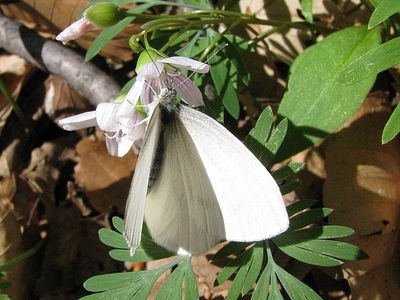 This season’s relentless rains have many of us desperate for some of the more benevolent signs of summer, such as butterflies. And now we have a better idea of just how diverse the butterfly population is, because the Vermont Center for Ecostudies has released the results of a six-year survey.
This season’s relentless rains have many of us desperate for some of the more benevolent signs of summer, such as butterflies. And now we have a better idea of just how diverse the butterfly population is, because the Vermont Center for Ecostudies has released the results of a six-year survey.
VPR’s Angela Evancie has more.
(Evancie) Here’s something you might not know about butterflies: Their names are like something out of a fantasy novel.
(McFarland) "Brown Elfin, Frosted Elfin, Bog Elfin, Great Spangled Fritillary…"
(Evancie) This is Kent McFarland, a conservation biologist and co-founder of the Vermont Center for Ecostudies in Norwich.
(McFarland) "Aphrodite Fritillary, Atlantis Fritillary, Jutta Arctic, Silver Spotted Skipper…I mean they’re just very poetic names, sometimes romantic names, and it sort of speaks to the fact that these are sort of like winged wildflowers."
(Evancie) Thanks to McFarland, the state of Vermont got its very first comprehensive butterfly atlas this year. It was almost ten years in the making, and long overdue:
(McFarland) "We’re really behind on understanding what’s going on out there with butterfly populations, compared to things like birds or mammals."
(Evancie) McFarland and his team fanned out across Vermont to look for butterflies in forests, fields and marshes. They had help from 140 citizen scientists.
(McFarland) "We collected something like 40,000 butterfly records in a six-year period. We found 103 species of butterflies, and that was maybe 16 more species than was known for the state."
(Evancie) The survey also helped determine which species of butterfly are of "conservation concern."
(McFarland) "Before we did this, there wasn’t a real good understanding of how many species we should be worried about – there was really only one that was on the radar screen that was called the West Virginia White. And we added sixteen species of conservation concern to the state list."
(Evancie) Climate change and the introduction of species that aren’t native to the area are two of the greatest threats to the species of conservation concern.
(McFarland) "103 species in a northern state like this is pretty phenomenal. But, we could easily see that go away, if we’re not careful."
(Evancie) So, how do you go about finding a butterfly? [fade up woods ambi] Kevin Hemeon of Hoosick Falls, New York, provides a quick lesson. He collected over 2400 records for the survey, and it earned him an honorary nickname:
(Hemeon) "They call me Sweet Nectar (laughs)…"
(Evancie) Hemeon leads a walk through Park McCullough’s Mile-Around Woods in North Bennington.
(Hemeon) "I usually look for, like I say, the larval plant…It usually grows along forested streams."
(Evancie) He’s looking for a plant called toothwort, which is where the West Virginia White – a species of conservation concern – lays its eggs.
(Hemeon) "Right here, this leaf – Three leaves, scalloped."
(Evancie) He checks under the toothwort for caterpillars, but no luck. One of the leaves has a tiny hole chewed out of it, so maybe they were here.
(Hemeon) "This plant goes dormant about July or so. These caterpillars have to mature before the plant goes dormant, or else they starve."
(Evancie) Hemeon says that West Virginia Whites sometimes mistake invasive garlic mustard for toothwort. Both plants are in the mustard family, but garlic mustard will actually kill young butterfly pupa that feed on its leaves.
(Hemeon) "And as that garlic mustard enters an area, within a few years, West Virginia Whites are gone."
(Evancie) So the search for butterflies becomes a search for garlic mustard.
(Hemeon) "Here it is…It looks almost like the seedling of say, a hollyhock. But see here – very small white flowers, in the mustard family, so it’s got four petals…But if you crush that and smell…"
(Evancie) "The leaf?"
(Hemeon) "Garlic."
(Evancie) "Oh, yeah."
(Evancie) Hemeon points out other dangers to butterfly habitat. The blight that’s killing beech trees, for example, means that another rare butterfly called Early Hairstreak loses its host plant.
And then there’s climate change.
(McFarland) "Butterflies are incredibly sensitive to climate for a variety of reasons. So that was a big reason for us to want to get a snapshot right now before we might see some serious climatic effects occur in the Northeast."
(Evancie) Kent McFarland says the butterfly survey will serve as a good reference point as more changes – especially climatic ones – happen in the future.
For VPR News, I’m Angela Evancie.